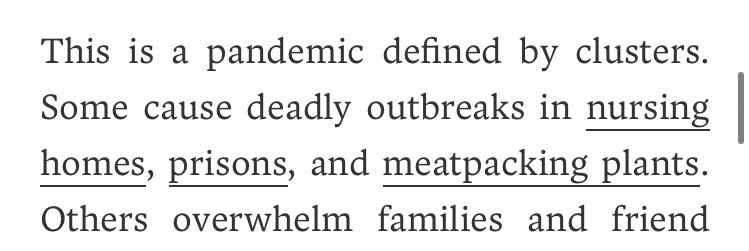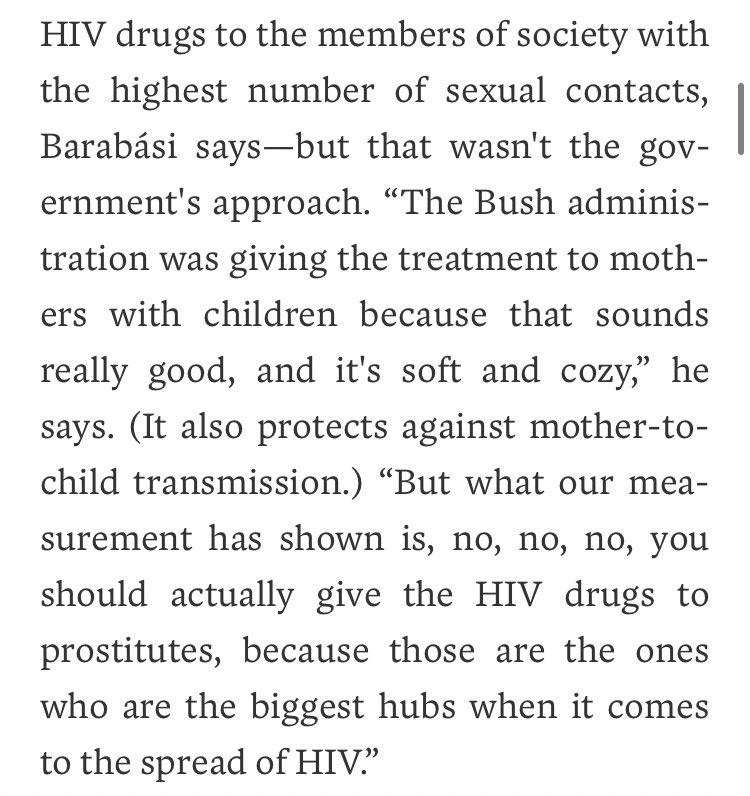Just a quick thread on an article (and a headline) that I find very troubling. https://www.wired.com/story/covid-19-vaccine-super-spreaders/
Firstly, see how we talk and write about the "vulnerable."
Please remember that the "vulnerable" are not expendable.
Please remember that the "vulnerable" are not expendable.
As the author points out, this does indeed seem to be a "pandemic defined by clusters" but the term "cluster" does not necessarily equate to "super-spreading-events." Also, those working in nursing homes and in meat packing plants, as well as the incarcerated...
...are most likely members of minority populations whose very incarceration/occupation puts them at increased risk. The author does not mention that members of these "vulnerable" communities have born the brunt of the pandemic, dying at almost 3x the rate of White/Non-Hispanics.
This is why the term "super-spreader" is unhelpful-it paints individuals as irresponsible & as operating outside of cultural/political/social constraints. As we have seen in meatpacking plants, many low-wage workers had no alternative but to continue to show up at work...
...with bills to pay and without quality medical care available to them, not to mention the lack of workplace safety/infection prevention measures in place. https://www.bbc.com/news/world-us-canada-52311877?utm_source=pocket&utm_medium=email&utm_campaign=pockethits
Also, asymptomatic transmission means many are unaware they are putting others at risk.
This article perpetuates the stereotypical image of a "super-spreader" as college-aged-party-goer, when we should be focusing on more positive messaging, instead of blame, towards a highly...
This article perpetuates the stereotypical image of a "super-spreader" as college-aged-party-goer, when we should be focusing on more positive messaging, instead of blame, towards a highly...
...literate population capable of acute behavior change.
I have patients in their 80's who have been with 10+ unknown partners in the past 3 months.
Stereotypes are not helpful!
I have patients in their 80's who have been with 10+ unknown partners in the past 3 months.
Stereotypes are not helpful!
"Eliminate the super-spreaders and you end the pandemic." We know this is simply not true. Yes, to persue those individuals with the most contacts is indeed a control strategy, we know that if the virus persists somewhere, it can persist anywhere (and vice-versa). Not so simple.
To speak from my experiences as part of covid, measles, tuberculosis responses, we as public health practitioners are tasked with tracking/tracing individual cases/contacts in an attempt to slow spread. This becomes difficult when cases reach 500+ for consecutive days...
..and is part of the reason why we cannot simply act on information about those individuals at the middle of several clusters. Our public health infrastructure has been underfunded over decades and we simply don't have the resources to react in real time. So we "...get stuck."
As an example of how to treat the "highly connected people" or the "hubs", the author refers to roll-out of HIV/AIDS programming in Africa. I understand the point being made, that commercial sex workers come into more contact than newborns, but efforts to protect babies from...
...vertical transmission, while also protecting those at the center of sexual networks, must be done in tandem, not one or the other!
We have to view disease prevention as a holistic process, involving multiple moving parts, many of which are cultural, historical, and social.
We have to view disease prevention as a holistic process, involving multiple moving parts, many of which are cultural, historical, and social.
A redeeming argument, that the "highest-risk populations are clearly defined" and that the vulnerable are in fact deserving of immediate protection.
For further discussion:
· Who defines "vulnerability"?
· How do we, how should we define what it means to "be vulnerable"?
· How does that designation affect individuals?
· How can public health efforts become more responsive to changes in real-time information?
· Any thoughts?
· Who defines "vulnerability"?
· How do we, how should we define what it means to "be vulnerable"?
· How does that designation affect individuals?
· How can public health efforts become more responsive to changes in real-time information?
· Any thoughts?
#publichealth #infectiousdiseases #CovidVaccine #COVID19 #COVID__19 #measles #tuberculosis #HIV #prevention #diseases #control #work #society #culture #holistichealth #history #MinorityHealth #humanity

 Read on Twitter
Read on Twitter








